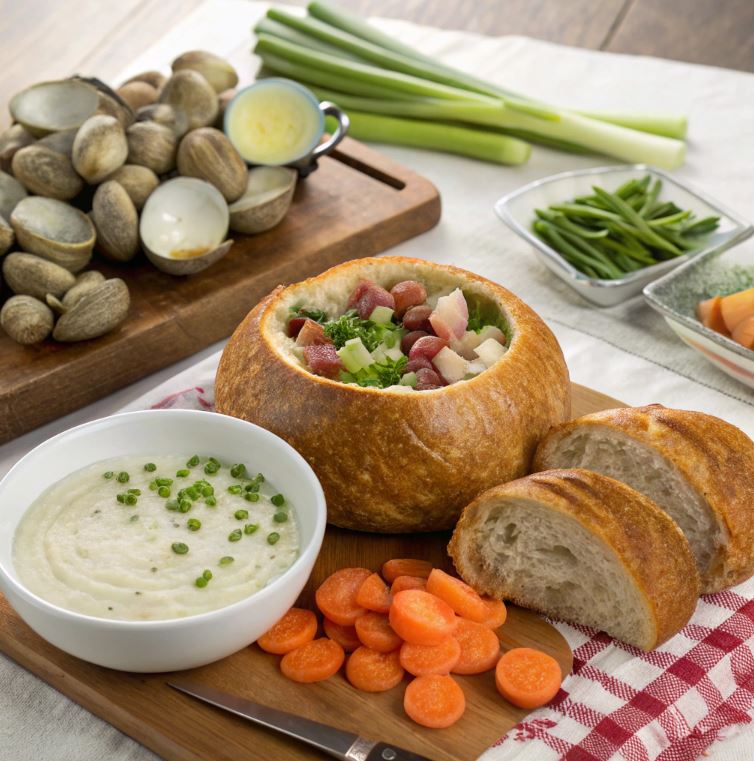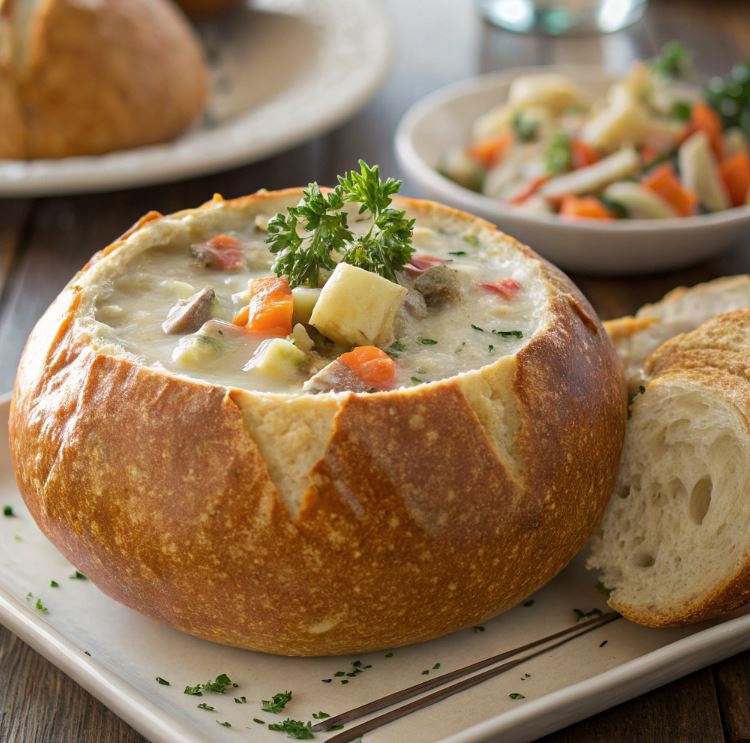Few dishes offer the same comforting experience as a clam chowder bread bowl. The rich, creamy soup combined with a crusty bread bowl creates the perfect balance of textures and flavors. This dish has remained a favorite in coastal regions, particularly in New England and San Francisco, where it is a staple of seafood cuisine.

The appeal of a clam chowder bread bowl lies not just in its flavor but also in its presentation. The edible bowl enhances the experience by absorbing the chowder’s creamy goodness while keeping the soup warm. Additionally, it eliminates the need for extra dishes, making it an environmentally friendly option.
Whether enjoyed on a cold evening or as a signature dish at a seafood restaurant, a well-prepared clam chowder recipe delivers unmatched satisfaction. This guide covers its history, global popularity, key ingredients, cooking tips, and health benefits.
History and Origins of Clam Chowder Bread Bowl
The roots of clam chowder bread bowl can be traced back to the early 18th century when European settlers in North America began making hearty seafood stews. New England, known for its abundant seafood, became the birthplace of traditional clam chowder. Early versions featured clams, potatoes, salt pork, and hardtack biscuits as thickening agents.
The introduction of the this recipe is often credited to San Francisco, where sourdough bread became a culinary icon. Fisherman’s Wharf restaurants popularized serving clam chowder in hollowed-out sourdough loaves, offering a practical and delicious way to enjoy the dish.
Over time, various regional adaptations emerged. While New England clam chowder uses a cream-based broth, Manhattan clam chowder features a tomato base. Despite these differences, this recipe remains an enduring favorite across different culinary traditions.
Clam Chowder Bread Bowl All Over the World
The clam chowder bread bowl has inspired variations across different cultures. While the original recipe remains a classic in the United States, other countries have embraced similar concepts using regional ingredients and flavors.
- United Kingdom: British seafood chowders often include smoked haddock, leeks, and cream, sometimes served in a crusty bread loaf.
- France: The French have their own version of seafood soup, bouillabaisse, but creamy seafood bisques are sometimes served in bread bowls.
- Italy: While Italians favor tomato-based seafood soups like cioppino, some coastal regions serve creamy seafood stews with rustic bread.
- Japan: Inspired by Western cuisine, Japanese seafood chowders sometimes incorporate miso for added depth of flavor.
Despite these variations, the appeal of a this recipe remains universal—combining hearty, creamy soup with a satisfying, edible vessel.
Detailed Ingredients for Clam Chowder Bread Bowl
Making the perfect clam chowder bread bowl starts with high-quality ingredients. Each component contributes to the dish’s signature richness and depth of flavor.

Key Ingredients:
- Fresh Clams: Littleneck or cherrystone clams provide the best texture and briny taste.
- Potatoes: Russet or Yukon Gold potatoes add thickness and a creamy consistency.
- Onions and Celery: These aromatics enhance the soup’s depth and balance.
- Heavy Cream: Essential for the signature richness of the chowder.
- Turkey Bacon: Adds smokiness and umami to the dish.
- Flour and Butter: Forms the roux, which thickens the chowder.
- Chicken or Seafood Stock: Provides a flavorful base.
- Sourdough Bread Bowl: A crusty loaf that holds the chowder and absorbs the creamy broth.
Freshly ground black pepper, bay leaves, and thyme further enhance the dish’s complexity.
Step-by-Step Instructions
A well-executed clam chowder bread bowl requires precise preparation and attention to detail. Follow these steps to achieve the perfect texture and flavor.
Step 1: Preparing the Clams
- Rinse clams thoroughly to remove sand.
- Steam clams in a pot with a small amount of water until they open.
- Remove the meat, chop finely, and set aside.
- Strain and reserve the clam juice for added flavor.
Step 2: Making the Chowder Base
- In a large pot, cook diced bacon or salt pork until crispy.
- Sauté onions and celery in the rendered fat until softened.
- Stir in butter and flour to create a roux, cooking until golden brown.
- Gradually add stock and reserved clam juice while stirring continuously.
Step 3: Cooking the Chowder
- Add diced potatoes and simmer until tender.
- Stir in chopped clams and season with salt, pepper, and thyme.
- Pour in heavy cream and let the chowder thicken over low heat.
Step 4: Preparing the Bread Bowl
- Cut off the top of the sourdough loaf and hollow out the center.
- Lightly toast the bread in the oven for extra crispiness.
Step 5: Serving the Clam Chowder Bread Bowl
- Ladle hot chowder into the bread bowl.
- Garnish with fresh parsley and serve immediately.
Tips for Perfect Clam Chowder Bread Bowl
Achieving the ideal clam chowder bread bowl requires careful attention to technique. Keep these tips in mind:
- Use Fresh Clams: Their briny flavor enhances the chowder.
- Avoid Overcooking: Clams become rubbery if cooked too long.
- Balance the Thickness: The chowder should be creamy but not overly thick.
- Choose the Right Bread: Sourdough works best due to its sturdy crust.
- Serve Immediately: The bread bowl will soften over time, so enjoy it while fresh.
Health Benefits of Clam Chowder Bread Bowl
While indulgent, a well-made clam chowder offers several nutritional benefits.
- Rich in Protein: Clams provide lean protein and essential amino acids.
- High in Vitamins: Clams contain vitamin B12, iron, and omega-3 fatty acids.
- Good Source of Fiber: The bread bowl adds dietary fiber.
- Boosts Immune Function: Garlic, onions, and fresh herbs contribute to overall wellness.
Although this recipe is calorie-dense, moderating portion sizes and choosing high-quality ingredients makes it a satisfying and nutritious choice.
Diet Information
The clam chowder bread bowl is a rich and hearty dish, but understanding its nutritional content can help make it part of a balanced diet. This dish is high in protein, thanks to the clams, which provide essential nutrients such as vitamin B12, iron, and omega-3 fatty acids. The soup’s creamy base contributes to calcium and healthy fats, while potatoes offer fiber and slow-digesting carbohydrates.
However, this recipe is also calorie-dense, primarily due to the heavy cream and bread. A single serving can contain over 500 calories, depending on portion size and ingredient choices. To reduce calories, consider using low-fat milk instead of heavy cream, increasing the ratio of vegetables to cream, or choosing a whole-grain bread bowl for added fiber.
For those following low-carb or gluten-free diets, serving the chowder in a bowl instead of bread is a great alternative. With mindful adjustments, this dish can fit into various dietary needs.
Making Clam Chowder Bread Bowl Kid-Friendly
Transforming a clam chowder bread bowl into a kid-friendly meal involves small adjustments in flavor and texture. While traditional chowder has a deep, briny seafood taste, children often prefer milder flavors.
- Use fewer clams: Some kids may not enjoy the strong seafood flavor, so reduce the clam quantity or finely chop them.
- Opt for a lighter base: Instead of heavy cream, try half-and-half or whole milk to make the chowder less rich.
- Add fun toppings: Sprinkle shredded cheese, bacon bits, or mild croutons on top to make it more appealing.
- Make mini bread bowls: Use smaller sourdough rolls for kid-friendly portions.
- Ensure a smooth texture: If children dislike chunky ingredients, blend part of the chowder for a creamier consistency.
With these adjustments, this recipe can become a family favorite that even picky eaters will enjoy.
Clam Chowder Bread Bowl Serving Suggestions and Pairings
A well-prepared clam chowder bread bowl pairs beautifully with complementary sides and beverages. Because the dish is rich and creamy, the right pairings can balance flavors and textures.
Best Side Dishes:
- Green Salad: A light salad with a citrus dressing cuts through the richness.
- Roasted Vegetables: Asparagus, Brussels sprouts, or zucchini add a fresh contrast.
- Oyster Crackers: A classic addition that enhances the chowder’s texture.
- Coleslaw: The crunchiness of coleslaw balances the creaminess of the chowder.
Ideal Beverages:
- White Wine: A crisp Chardonnay or Sauvignon Blanc complements the seafood.
- Iced Tea: A refreshing, lightly sweetened tea cleanses the palate.
- Lemon Water: The acidity of lemon water brightens up the dish.
Pairing this recipe with the right sides and drinks creates a well-rounded meal.
Common Mistakes to Avoid
Avoiding common mistakes ensures a perfectly creamy and flavorful clam chowder bread bowl.
- Overcooking the clams: Cooking clams too long makes them tough and rubbery. Add them at the end and heat briefly.
- Using the wrong bread: A soft bread bowl becomes soggy too quickly. Choose a thick-crusted sourdough loaf.
- Skipping the roux: The butter and flour roux thickens the chowder. Without it, the consistency may be too thin.
- Not rinsing clams properly: Sand in the clams can make the dish gritty. Soak and scrub them before use.
- Overloading with dairy: Too much cream can overpower the dish. Balance with broth and clam juice for depth of flavor.
By avoiding these mistakes, your recipe will have the right balance of flavors and textures.
Clam Chowder Bread Bowl Variations
The clam chowder bread bowl can be customized to suit different tastes and dietary preferences. Here are some creative variations:
- Dairy-Free Version: Substitute coconut milk or cashew cream for a creamy but lactose-free alternative.
- Spicy Twist: Add cayenne pepper, Old Bay seasoning, or diced jalapeños for a kick of heat.
- Seafood Mix: Enhance the dish with shrimp, scallops, or crab meat for a richer seafood experience.
- Vegetarian Chowder: Replace clams with mushrooms, corn, and extra potatoes for a plant-based version.
- Bacon Lovers’ Option: Mix in crispy bacon bits for a smoky, savory flavor.
These variations ensure that this recipe remains a versatile and exciting dish.
Storage and Reheating Tips
Proper storage and reheating techniques maintain the flavor and texture of a clam chowder bread bowl.
Storage Guidelines:
- Refrigerate properly: Store leftover chowder in an airtight container for up to 3 days.
- Avoid storing in bread bowls: Keep the chowder separate from the bread to prevent sogginess.
- Freeze with caution: Cream-based soups can separate when frozen. If freezing, leave out the dairy and add it when reheating.
Reheating Tips:
- Stovetop method: Heat chowder over low to medium heat, stirring frequently to prevent curdling.
- Microwave option: Use a low power setting, stirring every 30 seconds.
- Bread bowl preparation: Toast the bread bowl in the oven before refilling it with reheated chowder.
Following these tips keeps your clam chowder bread bowl fresh and delicious.
FAQ:
What is the best bread for a clam chowder bread bowl?
Sourdough bread is the best choice due to its sturdy crust and slightly tangy flavor, which complements the creamy chowder.
Can I make a clam chowder bread bowl without dairy?
Yes, substitute heavy cream with coconut milk, cashew cream, or a plant-based alternative.
How do I keep the bread bowl from getting soggy?
Lightly toast the inside of the bread bowl before adding chowder to create a protective barrier.
Is clam chowder bread bowl healthy?
While high in calories, it provides protein, vitamins, and minerals. Using lighter dairy options and whole-grain bread makes it healthier.
Can I make clam chowder ahead of time?
Yes, prepare the chowder in advance and store it separately from the bread. Reheat gently before serving.
Conclusion
A warm and creamy clam chowder bread bowl is a comforting dish that combines seafood richness with the heartiness of fresh bread. Its origins in coastal cuisine, paired with its versatility, have made it a favorite worldwide.
By selecting high-quality ingredients, avoiding common mistakes, and customizing flavors to personal preferences, anyone can create a restaurant-quality clam chowder bread bowl at home. With the right storage and reheating methods, it’s easy to enjoy leftovers without sacrificing taste.
Whether served as a special meal or an everyday indulgence, this dish remains a timeless classic.

